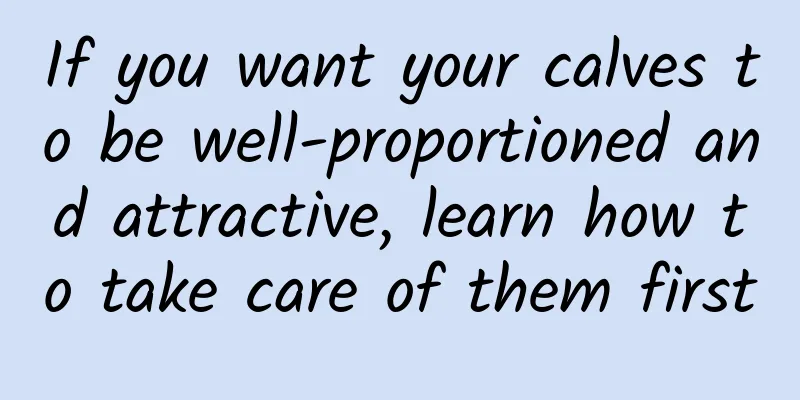If you want your calves to be well-proportioned and attractive, learn how to take care of them first

|
Which woman doesn’t love high heels? ! However, what you should learn is not just to make your calves beautiful by wearing high heels, but to start learning how to take care of and use them in your daily life! Every woman wants well-proportioned and beautiful calves. The simplest way is to use high heels to increase the proportions and become visually graceful in seconds! However, this method will not make your calves truly beautiful! The biggest problem for a neglected calf is that its shape starts to become unattractive! When the plantar fascia starts to become inflamed and refuses to heal, and walking becomes painful, that is the beginning of a serious problem! Therefore, if your plantar fascia has begun to become inflamed, you must learn how to maintain and rehabilitate it; if it has not yet occurred, you must take good care of it to avoid problems! I have mentioned in the past that wearing high heels frequently can cause tightness in the calf fascia and muscles. Over time, this tightness will become fixed and affect the range of motion of the ankle joint. If the sole of the foot begins to be tight for a long time, plantar fasciitis may occur. Of course, it is difficult to avoid chronic tight calf muscles that make you look like you have “carrot legs”! But in fact, it’s not just about wearing high heels! Your "walking posture" is what greatly affects the tightness of your calves and whether you become a high-risk group for plantar fasciitis! When walking, you should raise your legs and take longer steps to give your ankles more range of motion! First, let's understand the angle of movement of the soles of the feet, so that you can better understand the following methods of walking to maintain your calves Dorsiflexion: the calf muscles are lengthened Plantar flexion: calf muscles contract and tighten In the following photos, the calf is close to the ground when taking a step while walking, that is, the thigh is not raised while walking, resulting in no extra space for the ankle to move, and the ankle is in a state of little movement for a long time, and then the ankle affects the calf muscles. The calf is also in the same tight state for a long time, and begins to harden and even become inflamed. If you wear high heels for a long time, they will put you in a plantar flexion position, making your calves tighter. If your thighs are not raised when you walk, your calves will not have room to stretch at all, making them more likely to become inflamed and hardened! In the following photos, the thighs are pulled higher when walking, the calves are farther from the floor, the steps become larger, and the ankles have more activities for dorsiflexion and plantar flexion. As a result, the ankles have more range of motion, and the calf muscle fascia is greatly freed from the problem of being "forced into a fixed shape." So how can you practice to increase the range of your thigh lift when walking? Reminding yourself often is absolutely the first priority! In addition, the muscles below the abdomen must be strengthened! The following movements can simultaneously train the strength of the buttocks muscles and the strength of the lower abdomen and thighs. Tips: Put your weight on your supporting foot, keep your back straight, and lean forward (but don't lean too far). Practice the hip strength of the supporting foot and train the lower abdominal lifting strength of the other foot. Repeat 20 times on one side and then switch sides. Or static practice, Boat Pose is a great exercise for training your lower abdomen! You can maintain the still position for more than 20 seconds during the exercise, keeping your shoulder blades tight and your chest out (but not too much). After your lower abdominal muscle strength improves, you can try clamping weights between your calves to increase the intensity of your training. Or an exercise that works your abs and stretches your calves at the same time! Relaxing the fascia muscles is definitely the first priority in caring for the calf In addition to changing the way you walk, every day, first 1. relax the soles of your feet and calf fascia, 2. then stretch your calf muscles. This is very important! Use a roller to relax the calf fascia muscles. First, roll the entire calf. When you encounter a pain point, press it for three deep breaths, then quickly roll the area again to search for the next pain point! Remember, the feeling of pain should not exceed 70%, otherwise it will make the fascia muscles even tighter! Don’t ignore the fascia on the sides and front of your calves! Massage balls and peanut balls to relax calf fascia Stretch your calf muscles The calf is divided into an outer layer of the gastrocnemius muscle and an inner layer of the soleus muscle. Remember to stretch. Prepare by crossing one leg and bending the other. Take a deep breath, bend your knees, and pull your feet toward your torso without using too much force. This will stretch the soleus muscle on the inner layer of your calf. Then continue to take deep breaths and slowly straighten your calves, which will stretch the outer gastrocnemius muscle. This article comes from: Muscle Mom Blog ※For more information, please visit the blog of Kinniku Mama |
<<: Will you lose weight if you exercise? 4 weight loss myths to understand at once
>>: Get rid of the meat! 3 ways to tighten arm muscles and loosen shoulders and neck
Recommend
How to treat bacterial vaginosis
What is the most effective way to treat bacterial...
What are the symptoms of ectopic pregnancy?
Ectopic pregnancy is clinically called ectopic pr...
Is it normal to have abdominal pain after an abortion? What’s going on?
Many women become pregnant unexpectedly because t...
Can a premarital examination reveal a previous abortion? The truth is this
Many young people get pregnant unexpectedly befor...
Pregnancy complicated by ovarian cysts is a cause for concern
Jiali is 25 years old and will soon be a mother. ...
Multiple artificial abortions can cause cervical erosion
In life, many female friends will suffer from cer...
The number of people with eating disorders in the UK has increased by 16%
Recently, British artist Lady Gaga was reported t...
How to distinguish the common types of vaginitis?
Vaginitis is a very familiar gynecological diseas...
The top 5 domestic rices are released! Taijing No. 9 wins the championship
What kind of rice does your family eat? Although ...
What should female patients with cervical erosion eat? Diet therapy for patients with cervical erosion
If you suffer from cervical erosion, your health ...
What kind of surgery is suitable for myoma on the posterior wall of the uterus?
What kind of surgery is suitable for myoma on the...
What is the method to cure adnexitis and prevent recurrence?
How to treat adnexitis and prevent it from recurr...
What are the main symptoms of atrophic vulvar leukoplakia? Women should know
I think there should be quite a few women who hav...
Understand the classification of vulvar leukoplakia
Did you know that the clinical manifestations of ...
The brain revolution for weight loss! Should I throw the bread aside first to lose weight?
Many people make their own bread at home. Most pe...









